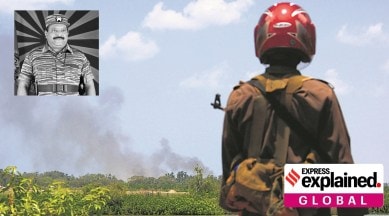How LTTE chief Prabhakaran died: Story of the final days of the Sri Lankan civil war
The three-decade war was brought to an end in May 2009 after Velupillai Prabhakaran was killed by the Sri Lankan army. An Indian Tamil nationalist has now claimed Prabhakaran is still alive.

On February 13, Tamil nationalist leader P Nedumaran claimed that Velupillai Prabhakaran, the leader of the Sri Lankan Tamil separatist group Liberation Tigers of Tamil Eelam (LTTE) was still alive, and would “announce his next plan (to liberate) Tamil Eelam very soon, himself”.
The LTTE had put up a final stand in Mullaitivu, a small fishing settlement in Sri Lanka’s Northern Province. The death of Prabhakaran brought the war to an end, and also effectively signalled the end of the LTTE, which had been militarily annihilated and left leaderless.
What happened in the final days of the Sri Lankan civil war, ending with Prabhakaran’s death?
The beginning of the end
In February 2002, the Sri Lankan government and the LTTE entered into a ceasefire brokered by Norway. However, by 2006, the truce was dead, with each side accusing the other of not sticking to the terms of the ceasefire.
While the LTTE carried out repeated guerilla attacks and suicide missions, the Sri Lankan army pushed deeper into the rebels’ eastern territories and then to the north.
In January 2008, the government of President Mahinda Rajapaksa formally announced the annulment of the ceasefire agreement after a bus carrying government soldiers to a military hospital in Colombo was targeted in a claymore mine attack.
Over the following year, the Sri Lankan forces pushed northwards, finally capturing Kilinochchi, the de facto administrative capital of the Tigers, in January 2009. Except for limited counter-attacks in Jaffna, the LTTE was not able to mount a counter-offensive.
Prabhakaran is believed to have told his Intelligence Chief Pottu Amman at the time that “75 per cent of the LTTE’s strength had gone downstream and they would have to hold on till the international community could stop the war”, defence analyst Ashok K Mehta wrote in a 2010 paper (Sri Lanka’s Ethnic Conflict: How Eelam War IV was Won).
Last stand at Mullaitivu
By April 2009, the Tigers were boxed into an 8-km sliver of the coast, along with some civilians, in Mullaitivu. Under international pressure, specifically from India which at the time was in the middle of a Lok Sabha election, the Sri Lankan government announced the end to the use of heavy weapons, including aircraft and aerial weapons. The area was designated as the ‘No Fire Zone’.
But this provided little relief to the LTTE. The Sri Lankan forces had blockaded the rebels from land and sea. “By May 11, the conflict zone was redesignated as the New Safety Zone (NSZ) and shrunk to 1.5 sq km with 700 Tigers and 50,000 civilians”, Mehta wrote. For the army, this was an internal hostage crisis – the Tigers were forcibly holding thousands of civilians with themselves, using them as human shields.
The LTTE was out of options. While the Sri Lankan government believed that the LTTE fighters might “resort to mass suicide”, Prabhakaran himself hoped to negotiate a ceasefire. When the government rejected offers of a negotiated truce, a daring escape plan was formulated.
According to Mehta, “The impossible escape plan had three phases: in the first phase, a group led by Prabhakaran would cross the Nanthikadal lagoon, and disperse in three groups in the east; in the second phase, a group led by B Nadesan was to negotiate a surrender for the sick and wounded; and in the third, a rearguard action was to be led by Prabhakaran’s son Charles Antony.”
However, less than 24 hours after the rebels launched their final salvo, the government forces had secured a swift and complete victory: not a single Tiger was left alive, even those waiving white flags from the beach in which they were cornered.
In the aftermath of the massacre, the Sri Lankan government came under heavy criticism for human rights abuses and for using heavy artillery in the NSZ.
The death of Prabhakaran
With the international media kept out of the conflict zone, several versions emerged of Prabhakaran’s death. The army claimed that he was killed as he tried to escape with a band of followers in an armour-plated van, with more rebel commanders accompanying them in a bus. After a two-hour exchange of fire, the Sri Lankan troops fired a rocket that hit the van, killing the rebel leader. Some versions of this story state that he was in an ambulance instead of a van.
Another version claimed that Prabhakaran was killed as he tried to break the blockade of the Lankan forces – and died fighting with his men.
One version also claimed that Prabhakaran died by suicide. Sri Lankan Tamil journalist DBS Jeyaraj wrote in 2021, “Prabhakaran’s body was discovered before dawn on Tuesday. The bodies of six bodyguards were found nearby. All indications were that Prabhakaran had committed suicide by placing a gun inside his mouth and firing upwards.”
Yet another version claims that Prabhakaran was captured by the army and then executed, with the single bullet injury to his temple cited as evidence. The University Teachers for Human Rights-Jaffna (UTHR-J), a Jaffna-based human rights group wrote in a special report that “Prabhakaran was tortured probably at Division 53 HQ in the presence of a Tamil government politician and a general”, before being executed, The Indian Express reported in 2009. The Sri Lankan government denied this account.
P Nedumaran’s recent claims have renewed speculation surrounding the circumstances of Prabhakaran’s death.
The Sri Lankan forces had at the time released a picture of the dead rebel leader, and had claimed to have confirmed his identity with a DNA test.